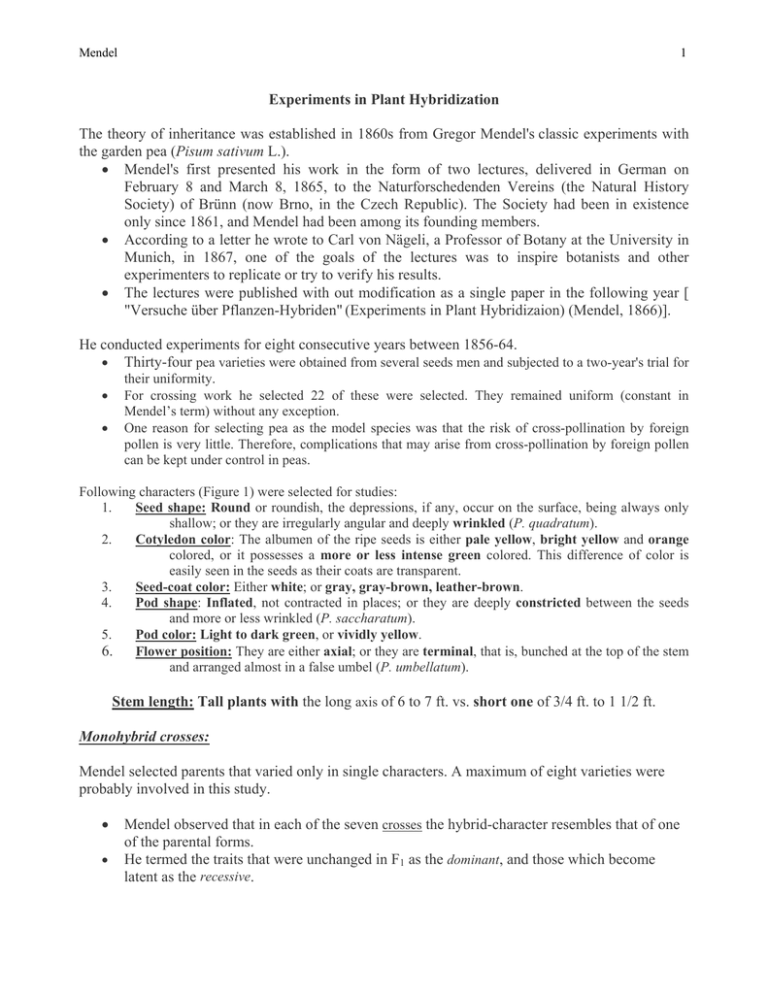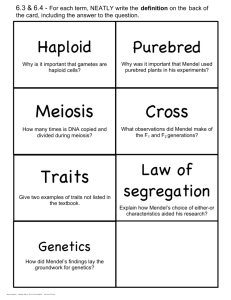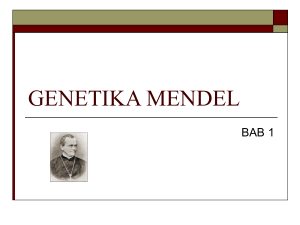Experiments in Plant Hybridization classic experiments with
advertisement

Mendel 1 Experiments in Plant Hybridization The theory of inheritance was established in 1860s from Gregor Mendel's classic experiments with the garden pea (Pisum sativum L.). • Mendel's first presented his work in the form of two lectures, delivered in German on February 8 and March 8, 1865, to the Naturforschedenden Vereins (the Natural History Society) of Brünn (now Brno, in the Czech Republic). The Society had been in existence only since 1861, and Mendel had been among its founding members. • According to a letter he wrote to Carl von Nägeli, a Professor of Botany at the University in Munich, in 1867, one of the goals of the lectures was to inspire botanists and other experimenters to replicate or try to verify his results. • The lectures were published with out modification as a single paper in the following year [ "Versuche über Pflanzen-Hybriden" (Experiments in Plant Hybridizaion) (Mendel, 1866)]. He conducted experiments for eight consecutive years between 1856-64. • Thirty-four pea varieties were obtained from several seeds men and subjected to a two-year's trial for • • their uniformity. For crossing work he selected 22 of these were selected. They remained uniform (constant in Mendel’s term) without any exception. One reason for selecting pea as the model species was that the risk of cross-pollination by foreign pollen is very little. Therefore, complications that may arise from cross-pollination by foreign pollen can be kept under control in peas. Following characters (Figure 1) were selected for studies: 1. Seed shape: Round or roundish, the depressions, if any, occur on the surface, being always only shallow; or they are irregularly angular and deeply wrinkled (P. quadratum). 2. Cotyledon color: The albumen of the ripe seeds is either pale yellow, bright yellow and orange colored, or it possesses a more or less intense green colored. This difference of color is easily seen in the seeds as their coats are transparent. 3. Seed-coat color: Either white; or gray, gray-brown, leather-brown. 4. Pod shape: Inflated, not contracted in places; or they are deeply constricted between the seeds and more or less wrinkled (P. saccharatum). 5. Pod color: Light to dark green, or vividly yellow. 6. Flower position: They are either axial; or they are terminal, that is, bunched at the top of the stem and arranged almost in a false umbel (P. umbellatum). Stem length: Tall plants with the long axis of 6 to 7 ft. vs. short one of 3/4 ft. to 1 1/2 ft. Monohybrid crosses: Mendel selected parents that varied only in single characters. A maximum of eight varieties were probably involved in this study. • • Mendel observed that in each of the seven crosses the hybrid-character resembles that of one of the parental forms. He termed the traits that were unchanged in F1 as the dominant, and those which become latent as the recessive. Mendel • 2 The dominant character was found to be contributed equally by either the seed or the pollen parent. Mendel observed following traits to be dominant: • Round seed shape. • Yellow cotyledon. • Gray, gray-brown, or leather brown seed-coat. • Inflated pod shape. • Green pod color • Flowers along the stem (axial) • Greater length of stem (tall plant). First two traits seed shape and cotyledon color were scored among F2 seeds, whereas for others F2 plants were grown for their expression. 1. Seed shape: From 253 F1 hybrids 7324 seeds were obtained, among them were 5474 round and 1850 wrinkled. The ratio was 2.96:1. 2. Cotyledon color (Color of albumen.): 258 plants yielded 8023 seeds, 6022 yellow, and 2001 green; their ratio, therefore, is as 3.01:1. 3. Seed-coat color: Among 929 plants, 705 bore violet-red flowers and gray-brown seed-coats; 224 had white flowers and white seed-coats producing a 3.15:1 ratio. 4. Pod shape: Of 1181 plants, 882 had them simply inflated, and in 299 they were constricted. Ratio: 2.95:1. 5. Pod color: The number of trial plants was 580, of which 428 had green pods and 152 yellow ones. Ratio was 2.82:1. 6. Flower position: Among 858 cases 651 had inflorescences axial and 207 terminal. Ratio, 3.14:1. 7. Stem length: Out of 1064 plants, in 787 cases the stem was long, and in 277 short resulting a ratio of 2.84:1. The Second Generation From the Hybrids • Mendel observed no further segregation of the ¼ th class carrying the recessive trait, which • remain constant among their progenies. He observed that 2/3 rd of the dominant class segregated to yield offspring which display the dominant and recessive characters in the proportion of 3:1, and thereby show exactly the same ratio as the hybrid forms, while 1/3 rd remain showed no segregation and remain constant for the dominant character. For the first two traits seed shape and cotyledon color, he studied 565 and 519 plants, respectively. These traits were expressed in the embryos, and therefore, could be scored among the F2 seeds with out growing progeny plants. On the contrary, he had to grow F3 progeny plants to score other five traits. For these five traits he selected 100 F2 plants that displayed the dominant character, and ten F3 seeds of each F2 plants were cultivated. “In each of these experiments a certain number of the plants came constant with the dominant character.” (did not segregate) • • He observed 1/3 rd of the plants remain constant or fixed with certainty. Whereas, two-thirds of the hybrid-character segregated to both contrasting phenotypes. Mendel 3 Mendel’s conclusions: “It is now clear that the hybrids form seeds having one or other of the two differentiating characters, and of these one-half develop again the hybrid form, while the other half yield plants which remain constant and receive the dominant or the recessive characters in equal numbers.” “With regard to those hybrids whose progeny is variable: • we may perhaps assume that between the differentiating elements of the egg and pollen cells there also occurs a compromise, in so far that the formation of a cell as the foundation of the hybrid becomes possible; • but, nevertheless, the arrangement between the conflicting elements is only temporary and does not endure throughout the life of the hybrid plant. Since in the habit of the plant no changes are perceptible during the whole period of vegetation, • • • we must further assume that it is only possible for the differentiating elements to liberate themselves from the enforced union when the fertilizing cells are developed. In the formation of these cells all existing elements participate in an entirely free and equal arrangement, by which it is only the differentiating ones which mutually separate themselves. In this way the production would be rendered possible of as many sorts of egg and pollen cells as there are combinations possible of the formative elements.” These are Mendel’s interpretations for the law of segregation that we currently known. The Subsequent Generations From the Hybrids Mendel studied the segregation of • seed shape and cotyledon color for 6 generations; • other five traits 4-5 geneations with a small number of plants; • and always observed segregation of 2:1:1 into hybrids and “constant forms” (dominant and recessive classes). He used ‘A’ and ‘a’ to show ‘AA’ and ‘aa’ genotypes, respectively. From his investigation he concluded that the number of constant genotypes in a given class can be calculated by using the formula; 2n-1=210-1= 1023 (n= number of selfed generation) Among 2048 plants in the 10th generation 1023 with the constant dominant character, 1023 with the recessive character, and only two hybrids. • [This also implies that traits are fixed with selfing (recombinant inbred lines from single seed decent method of breeding)]. The Offspring of Hybrids in Which Several Differentiating Characters are Associated. Mendel studied di- as well as tri-hybrid crosses. Mendel 4 Di-hybrid cross: • First Experiment: • AB Seed parents, A form round B albumen yellow 556 F2 seeds segregated into: 1. 315 round and yellow, 2. 101 wrinkled and yellow, 3. 108 round and green, 4. 32 wrinkled and green. ab Pollen parents, a form wrinkled b albumen green To determine the genotypes of the segregants Mendel grown the F2 plants and scored the F3 seeds in the following year. The offspring of the hybrids appeared therefore under 9 different forms, some of them in very unequal numbers. 38 plants with the sign AB 35 " " " Ab 28 " " " aB 30 " " " ab 65 " " " ABb 68 " " " aBb 60 " " " AaB 67 " " " Aab 138 " " " AaBb These genotypes were classified into three different groups. • The first included those with the signs AB, Ab, aB, and ab: they are homozygous (constant) • The second group included the signs ABb, aBb, AaB, Aab: these are homozygous (constant) in one character and hybrid in another, and vary in the next generation only as regards the hybrid-character. • The third group comprised of AaBb, hybrid (heterozygous) in both characters. Mendel expressed the progenies for a di-hybrid cross (two kinds of differentiating characters) in the following form. • AB + Ab + aB + ab + 2ABb + 2aBb + 2AaB + 2Aab + 4AaBb He derived the classes of the series by the combination of the expressions: A + 2Aa + a B + 2Bb + b Tri-hybrid cross: • Second Experiment: ABC Seed parents, abc Pollen parents A form round B albumen yellow C seed-coat gray-brown a form wrinkled b albumen green c seed-coat white From the tri-hybrid or hybrids from original parents differing for 3 characters resulted the following expression: ABC + ABc + AbC + Abc + aBC + aBc + abC + abc + 2ABCc + 2AbCc + 2aBCc + 2abCc + 2ABbC + 2ABbc + Mendel 5 2aBbC + 2aBbc + 2AaBC + 2AaBc + 2AabC + 2Aabc + 4ABbCc + 4aBbCc + 4AaBCc + 4AabCc + 4AaBbC + 4AaBbc + 8AaBbCc. He derived the classes of the series by the combination of the expressions: A + 2Aa + a B + 2Bb + b C + 2Cc + c Mendel conducted further experiments with a smaller number of experimental plants in which the remaining characters by twos and threes were united as hybrids and observed approximately the same results. Mendel concluded: “The offspring of the hybrids in which several essentially different characters are combined exhibit the terms of a series of combinations, in which the developmental series for each pair of differentiating characters are united. It is demonstrated at the same time that the relation of each pair of different characters in hybrid union is independent of the other differences in the two original parental stocks.” This is the summary for the law of independent assortment. Mendel came up with the following formulae for segregating progenies: “If n represent the number of the differentiating characters in the two original stocks, • 3n gives the number of terms of the combination series, • 4 n the number of individuals which belong to the series, and • 2 n the number of unions which remain constant. • The series therefore contains, if the original stocks differ in four characters, 34 = 81 classes, 44 = 256 individuals, and 24 = 16 constant forms: or, which is the same, among each 256 offspring of the hybrids are 81 different combinations, 16 of which are constant.” The Reproductive Cells of the Hybrids Mendel came to conclusions as regards the composition of the egg and pollen cells of hybrids from his studies. He considered two forms which were constantly different in the form of the seed and the color of the albumen for this analysis. AB Seed parents, ab Pollen parents, A form round a form wrinkled B albumen yellow b albumen green Following back and test crosses in reciprocal combinations were made. • The hybrids with the pollen of AB • The hybrids with the pollen of ab • AB with the pollen of the hybrids. • ab with the pollen of the hybrids. From this study Mendel concluded that • “the pea hybrids form egg and pollen cells which, in their constitution, represent in equal numbers all constant forms which result from the combination of the characters united in fertilization.” Mendel • • • 6 The series from the monohybrid cross is represented by the expression A+2Aa+a, in which A and a signify the forms with constant differentiating characters, and Aa the hybrid form of both. It includes in 3 different classes of 4 individuals. In the formation of these, pollen and egg cells of the form A and a take part on the average equally in the fertilization; hence each form [occurs] twice, since four individuals are formed. There participate consequently in the fertilization The pollen cells: The egg cells • A+A+a+a, A+A+a+a. Each pollen form A and a will unite equally often with each egg cell form A and a, consequently one of the two pollen cells A in the fertilization will meet with the egg cell A and the other with the egg cell a, and so likewise one pollen cell a will unite with an egg cell A, and the other with the egg cell a. Pollen cells Egg cells A | | | A A a \/ X /\ A a a | | | a Male Female a A A AA Aa a Aa aa Mendel then expanded this to two and three character crosses and concluded that: • The hybrids produce egg cells and pollen cells which in equal numbers to represent all constant forms that result from the combinations of the characters brought together in fertilization.” Experiments with Hybrids of Other Species of Plants • • He then conducted two minor experiments with species of Phaseolus. An experiment with Phaseolus vulgaris and Phaseolus nanus gave results in perfect agreement. A tri-hybrid cross between P. nanus (dwarf axis, simply inflated, green pods) and P. vulgaris (tall plant, constricted pods and yellow pods) resulted ratios of different forms in the separate generations comparable to that observed in Pisum spp. He, however, observed deviation of the ratio of flower color from 3:1. He observed a remarkable change of color in the flowers and seed of the hybrids and obtained only one out of 31 plants with white flowers. The remaining 30 plants developed flower-colors which were of various grades of purple-red to pale violet. • “Even these enigmatical results, however, might probably be explained by the law governing Pisum if we might assume that the color of the flowers and seeds of P. multiflorus is a combination of two or more entirely independent colors, which individually act like any other constant character in the plant.” • “This coloring appears only once in the series, and could therefore also only be developed once in the average in each 16, and with three color characters only once even in 64 plants.” Mendel 7 Mendel’s Concluding Remarks • If it be accepted that the development of hybrids follows the law which is valid for Pisum, the series in each separate experiment must contain very many forms, since the number of terms, as is known, increases with the number of the differentiating characters as the powers of three. • For instatnec, for seven differentiating characters the combination series contains 16,384 individuals under 2187 various forms. • If, furthermore, there appear among the differentiating characters at the same time dominant characters, which are transmitted entire or nearly unchanged to the hybrids, then in the terms of the developmental series that one of the two original parents which possesses the majority of dominant characters must always be predominant. • For the history of the evolution of plants this circumstance is of special importance, since constant hybrids acquire the status of new species. • With Pisum it was shown by experiments that the hybrids form egg and pollen cells of different kinds, result the variability of their offspring. • For the purpose of propagation, one pollen cell and one egg cells unite in flowering plants into a single cell, which is capable by assimilation and formation of new cells to become an independent organism. In Pisum it is placed beyond doubt that for the formation of the new embryo a perfect union of the elements (genes) of both reproductive cells must take place. • If it chance that an egg cell unites with a dissimilar pollen cell, we must then assume that between those elements of both cells, which determine opposite characters some sort of compromise is effected. The resulting compound cell becomes the foundation of the hybrid organism the development of which necessarily follows a different scheme from that obtaining in each of the two original species. • In the formation of hybrid cells all existing elements participate in an entirely free and equal arrangement, by which it is only the differentiating ones which mutually separate themselves. In this way the production would be rendered possible of as many sorts of egg and pollen cells as there are combinations possible of the formative elements. • The behavior of each pair of differentiating characters in hybrid union is independent of the other differences between the two original plants, and, further, that the hybrid produces just so many kinds of egg and pollen cells as there are possible constant combination forms.




